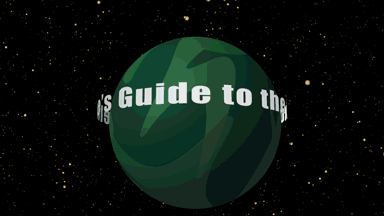Scienceline’s Guide to the Exoplanets: The Methane Ghost
Gliese 581f: A frigid sea that could be
Rahul Rao • August 17, 2020

Your favorite planets, and you didn't even know they existed. [Credit: Curtis Segarra | CC BY-NC-ND 2.0]
The Methane Ghost
Gliese 581f
Discovered by: Nobody
Discovered: Does not exist
Distance from Earth: ~20 light-years
Mass: None
Surface climate: We’ll talk about this.
Habitability for humans: You can’t live on a planet that doesn’t exist
This time, we’re not talking about a world that exists, but rather a world that almost certainly doesn’t. There is a reason for that.
The red dwarf Gliese 581 is one of the most famous stars in the realm of exoplanets; it might have at least three to five exoplanets, some of which exist in its habitable zone. “Might” is the operative word here, of course, as various observations of the system since 2005 have only thrown in several layers of noise and confusion and conflicting results. As of tonight, astronomers consolidating the evidence have corroborated the existence of three planets — Gliese 581e, c, and b, in order out from the star — with another two — g and d — thought but not confirmed to exist.
And then there’s Gliese 581f. It was “discovered” in 2010, then almost immediately retracted as observational noise. Were it to exist, it would be the farthest known planet from its star by far: around 1 AU. While the distance from the Earth to the Sun might not seem far to us, it’s a far larger distance to be from a red dwarf. That would put it deep in the outer solar system, or the equivalent thereof, where temperatures are well below freezing.
The reason I bring it up is because, were it to exist, it could be an especially strange (by Earth standards) type of planet which astronomers have barely begun to consider: a methane ocean world.
We’ve talked about ocean worlds in this space before. They’re planets covered entirely with liquid water, forming oceans dozens if not hundreds of miles deep where, at the bottom, water gives way not to rock but to strange crystals of exotic ice. In the realm of exoplanets, liquid water around other stars does tend to excite people.
But liquid methane means that planets far colder than those in the traditional habitable zone can still host some sort of ocean. Those oceans would be frigid, at somewhere between -300 and -250 degrees Fahrenheit (-180 and -160 degrees Celsius), but you don’t have to look far to find them. Consider Titan, Saturn’s moon, which has oceans of methane hidden under its thick atmosphere.
It’s not too large a stretch to think that there are worlds covered by colossal oceans of liquid methane. Indeed, some astronomers think that there might be a “liquid methane zone” around planets. They think that, as common as water worlds might be, they might be no more than a comparative drop in the bucket; it could be methane, not water, that dominates the ranks of planets.
Unfortunately, as the Gliese 581f example shows, planets that are distant enough from their star to host methane are much harder to find. They don’t block as much light, and they don’t influence their star gravitationally quite as much as their nearer counterparts. Perhaps that’s why they remain, for now, in the shadows.